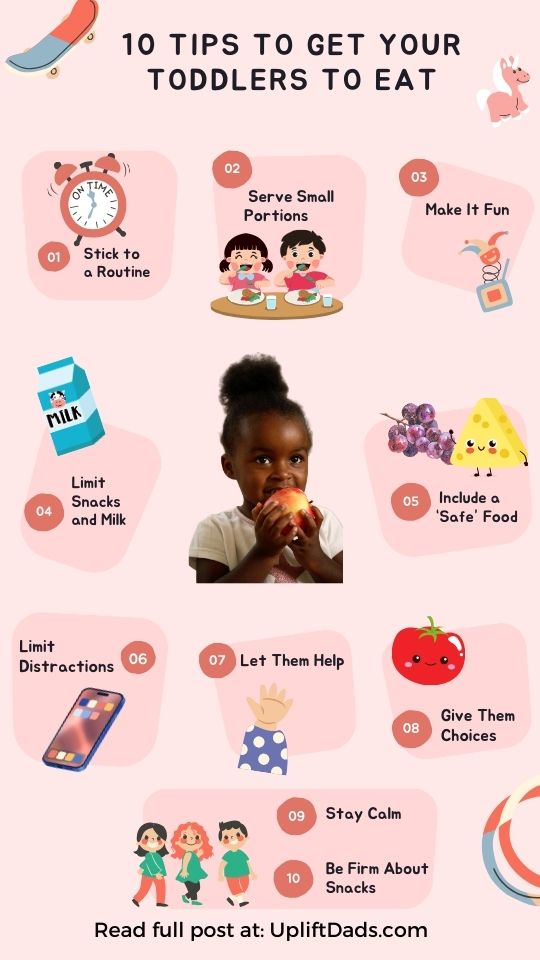Disclaimer: I’m just a dad sharing what’s worked for my picky eaters (and what hasn’t).
Always consult a pediatrician or feeding therapist if you’re concerned about your toddler’s eating habits.

1. Why Do Toddlers Refuse to Eat?
As someone who grew up eating whatever was put on the table (and enjoying it), watching my daughter refuse to eat anything but plain pasta is honestly painful.
But here’s the thing: refusing food is normal for toddlers.
They’re flexing their independence, their appetites are smaller than when they were babies, and sometimes they’re just not in the mood.
Add teething, distractions, or sensory quirks, and it’s a perfect storm.
2. What NOT to Do
When your toddler refuses to eat, it’s tempting to try everything to get food into them, but some tactics can backfire:
- Don’t Force Them to Eat
Making them take “just one more bite” can turn mealtime into a power struggle.
It’s stressful for everyone.
- Avoid Rewards and Punishments:
Saying, “If you eat your broccoli, you’ll get ice cream” might work short-term, but it teaches them that healthy food is a chore or something to “get through” so they can enjoy the good stuff.
On the flip side, punishing your toddler for not eating (e.g., “You can’t leave the table until your plate is clean!”) can turn mealtimes into a source of anxiety and negativity.
- Don’t Make Separate Meals
Making a separate “backup” meal for your toddler sends the message that they don’t need to try anything new because they’ll always get their favorite.
Instead, serve one meal for the whole family, but make sure there’s at least one “safe” food your toddler likes—something simple like bread, cheese, or fruit.
This way, they have something familiar to eat while still seeing the rest of the meal.
- Don’t Use Distractions
Screens or toys might help them eat now, but it doesn’t teach healthy habits.
- Don’t Panic About Skipped Meals
If they skip a meal, it’s okay.
Toddlers are good at eating when they’re hungry.
Offer the next meal or snack as usual.
3. What You Can Do: Top 10 Tips to Get Your Toddler to Eat

Tip 1. Stick to a Routine
Toddlers are creatures of habit.
Having a consistent meal and snack times helps their little bodies know when it’s time to eat.
No surprises = less drama.
Tip 2. Serve Small Portions
A mountain of food can feel overwhelming for a toddler.
Start small—like a tablespoon of each food—and let them ask for more.
It’s amazing how a little freedom can make them more excited about eating.
Tip 3. Make It Fun
Food doesn’t have to be boring!
Change the shape, texture, or even color.
My daughter lives for heart-shaped pancakes, and my son?
He’ll eat almost anything if he can dip it in ketchup or yogurt.
Get creative!
Tip 4. Limit Snacks and Milk
I used to think, “Well, at least she’s drinking milk,” until I realized she wasn’t hungry for meals.
Keep snacks small and spaced out, and don’t let milk take the place of food—it’s filling but not as nutritious.
Tip 5. Include a “Safe” Food
If your toddler has a favorite food (like plain rice or cheese), include it on their plate, but also introduce one or two new options alongside it.
Having that familiar food there gives them confidence, while exposure to new foods keeps expanding their palate.
Tip 6. Limit Distractions
Picture this: one kid clutching a toy, a cartoon blaring in the background, and your teen practicing TikTok dances nearby.
Sound familiar?
Yeah, that’s not helping.
Turn off the screens, clear the table, and create a calm, distraction-free mealtime so your toddler can actually focus on eating.
Tip 7. Let Them Help
Kids are more likely to try foods they helped prepare.
Let them stir a bowl, sprinkle cheese, or even wash veggies.
It might get messy, but it’s worth it when they proudly announce, “I made this!” before taking a bite.
Tip 8. Give Them Choices
Toddlers love feeling in control.
Offer choices from the food you’ve prepared—“Do you want carrots or cucumbers?”—and let them decide how much they eat.
This small amount of autonomy can go a long way.
Tip 9. Stay Calm
Look, I’ve been there—watching them take two bites, saying “all done,” and pushing the plate away is maddening.
But forcing or bribing them only creates stress for everyone.
Trust me, patience and calmness will win in the long run (even if it doesn’t feel like it at the moment).
Tip 10. Be Firm About Snacks
Sometimes toddlers insist they’re hungry just to grab a snack, but they’re not really hungry for meals.
Setting boundaries like, “No snacks until after lunch,” can help them learn that mealtime is for eating.
A little discipline here goes a long way.
4. Learn More from Trusted Sources
Refusing to eat is just a phase (even though it feels eternal when you’re in it).
But if your toddler is losing weight, avoiding entire food groups, or gagging/choking regularly, it’s time to consult your pediatrician.
Here’s where I’ve found helpful advice when I needed extra support:
Videos: Tips for Feeding Picky Eaters
Books: Child of Mine: Feeding with Love and Good Sense by Ellyn Satter.
The Big Picture
Meal times should be positive and stress-free.
If your current approach isn’t working, try stepping back and walking in your toddler’s shoes.
Remember, toddlers don’t see food the same way adults do.